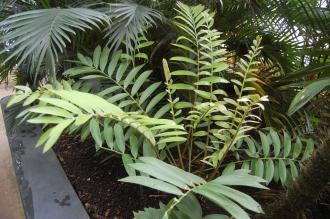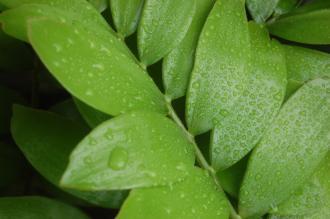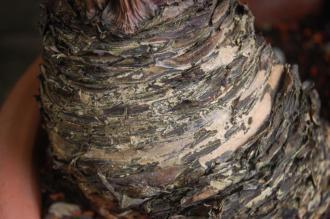
Zamia furfuracea (28/02/2016, Kew Gardens, London)
Position: Full sun to light shade
Flowering period: N/A
Soil: Moist, well drained
Eventual Height: 1.3m
Eventual Spread: 2m
Hardiness: 9b, 10a, 10b, 11
Family: Zamiaceae
Zamia furfuracea is a slow growing evergreen cycad with clump forming habit. Its mid green leaves are pinnate, up to 1.5m long and 40cm across. Its leaflets are obovate with entire margins, occasionally toothed towards their tips, 20cm long and 5cm across. Its trunk may achieve a length of up to 20cm. This plant produces male and female cones on separate plants, the female being brown and egg shaped and up to 20cm long and 7 cm across, the male being cylindrical, up to 12cm long and 2.5cm across.

Zamia furfuracea Leaf (28/02/2016, Kew Gardens, London)
Zamia furfuracea, commonly known as Cardboard Palm or Cardboard Cycad, is native to east Mexico. In its native habitat it grows in arid thorn scrub. This plant is considered as Endangered according to The IUCN Red List of Threatened Species. It should be noted that all parts of this plant are poisonious.
The etymological root of the binomial name Zamia a name in Pliny refers to the sterile appearance of the staminiferous cones. Furfuracea is derived from the Latin furfur meaning ‘scaly’.
The landscape architect may find Zamia furfuracea useful as container grown foliage houseplant, suitable for bright conditions. Once established this plant is drough tolerant.
Ecologically, Zamia furfuracea is of little value to UK wildlife.

Zamia furfuracea Trunk (28/02/2016, Kew Gardens, London)
Zamia furfuracea prefers moist, well-drained soils. It tolerates most pH of soil.
When maintaining Zamia furfuracea as a houseplant its soil should be watered regularly, but never wet. Watering should be reduced during the winter months. Its preferred active growing temperature rages from between 16ºc to 24ºc, although it will tolerate a temperature as low as near freezing. Feeding with weak fertiliser solution should be carried out once a month during the growing season.

Landscape Architecture

